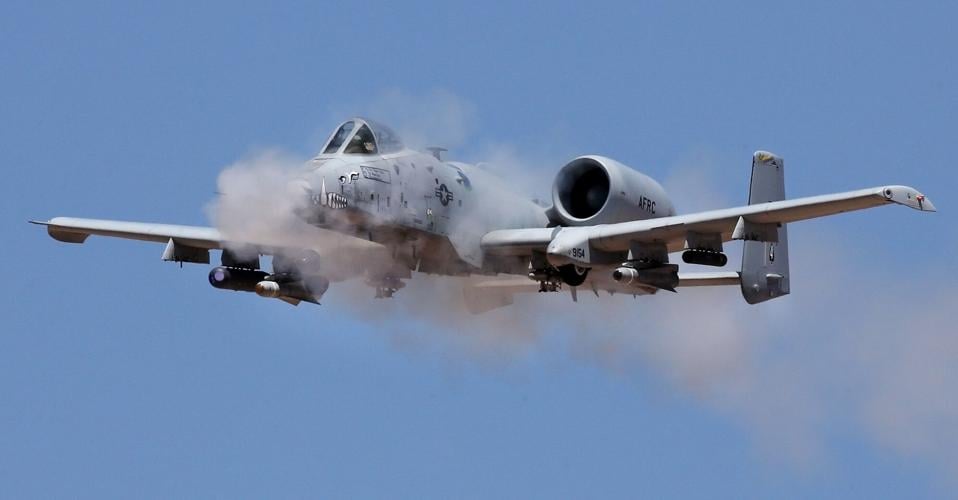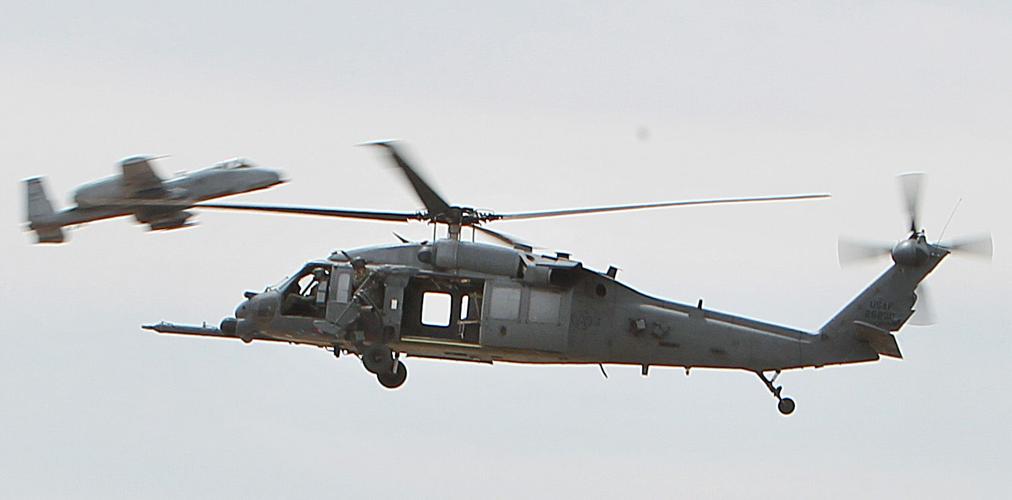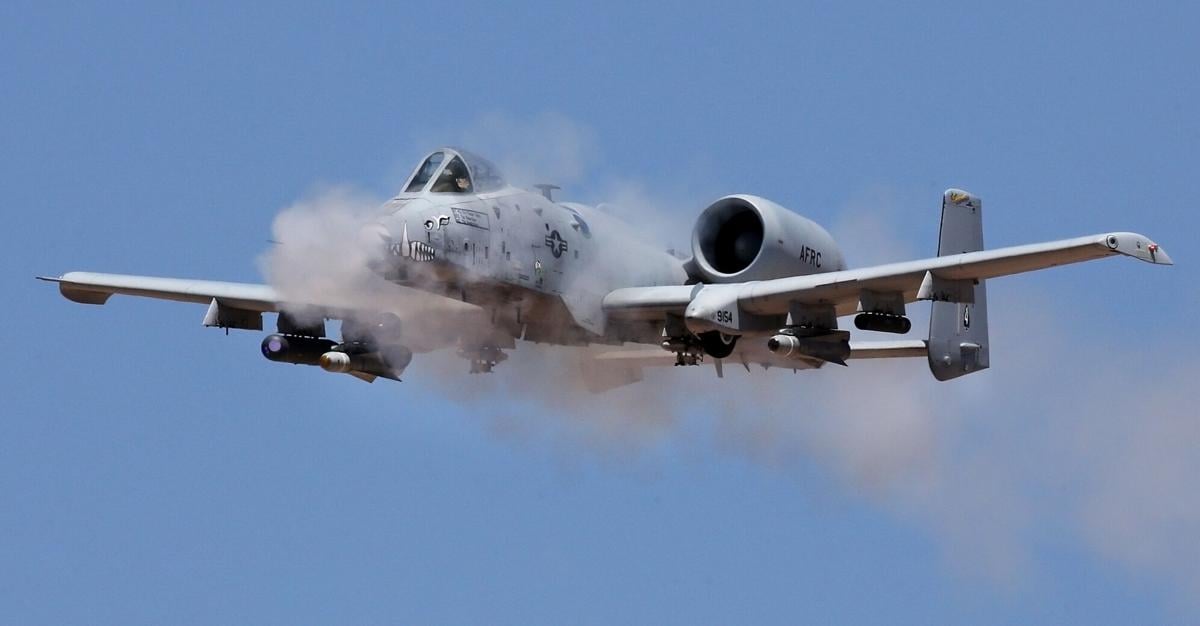Davis-Monthan Air Force Base would lose its active-duty A-10 fighter squadron but gain A-10 and rescue units from Nellis Air Force Base in Nevada, under a realignment plan announced by the Air Force.
Nellis units operating A-10 Thunderbolt II attack jets and HH-60 Pave Hawk rescue helicopters would be transferred to Davis-Monthan, under the first phase of a proposed plan, released as part of the Air Force’s fiscal year 2022 budget request.
But that plan is contingent on congressional approval of the retirement of 42 A-10 aircraft, including 35 now at Davis-Monthan AFB, the Air Force said.
But moving the A-10 and HH-60 aircraft squadrons, one maintenance squadron and all the supporting personnel from Nellis will result in a small personnel increase at D-M, the Air Force said.
D-M is home to one A-10 combat unit — the 354th Fighter Squadron “Bulldogs” — as well as an active-duty A-10 training squadron and an Air Force Reserve A-10 training squadron, as well as rescue squadrons, under the host 355th Wing.
The moves will free up more space for more F-35 fighter-jet squadrons at Nellis and are part of a larger plan make the Tucson base home to “centers of excellence” for combat search and rescue, the Air Force said.
“This realignment will consolidate all A-10 and HH-60 test, training, and weapon school activity at one location, allowing airmen in these mission areas to train together for future threats.” Acting Air Force Secretary John P. Roth said in a news release.
Members of Arizona’s congressional delegation have long opposed retirement of the A-10 “Warthog,” including the latest plan, citing the plane’s unmatched capabilities at close air support of ground troops.
Seven current Arizona legislators sent a letter to Air Force secretary in late May, opposing the most recent A-10 retirement plan.
Local government and business leaders have worried that phasing out the A-10 without a comparable replacement mission would jeopardize the long-term viability of D-M, which pumps nearly $1 billion into the Tucson economy annually.
Amber Smith, president and CEO of the Tucson Metro Chamber and a leader of local military-support groups, said she’s encouraged by the realignment plan.

A HH-60 Pave Hawk helicopter during a search-and-rescue demonstration at the 2014 Thunder and Lightning Over Arizona Open House at Davis-Monthan Air Force Base as an A-10 Thunderbolt II (background) provides air cover.
“Consistently we have sent the message that Tucson is a great location for any and all flying missions with our assets of weather, airspace, and proximity to the Goldwater range and other military installations,” said Smith, a member of the DM50 who sits on the executive committee for the Southern Arizona Defense Alliance.
Under the realignment plan, the Air Force said, the A-10 Weapons Instructor Course and test and evaluation operations at Nellis will move to D-M in 2022.
The HH-60 weapons, test combat coded units, including the 88th Test and Evaluation Squadron, 66th Rescue Squadron, 58th Rescue Squadron, the 34th Weapons Squadron and the 855th Aircraft Maintenance Squadron will move beginning in 2024.
The Air Force said it plans to modernize and maintain 218 of its current fleet of 281 combat-capable A-10s.
In 2019, the Air Force awarded Boeing a contract worth nearly $1 billion to make for new wings to extend the life of 109 remaining A-10s, after previously providing 173 new wing sets.
With avionic upgrades, the remaining A-10s will be able to fly well into the 2030s, the Air Force said.
Photos: Davis-Monthan Air Force Base history
Davis-Monthan AFB, 1927
Updated
1927: Col. Charles A. Lindbergh dedicating Davis Monthan Field in 1927. At that time it was the largest municipal airport in the U.S.
Davis-Monthan AFB history
Updated
1927: Charles Lindbergh dedicated Davis-Monthan Air Field field on Sept. 27, 1927, for 2nd Lts. Samuel H. Davis and Oscar Monthan, Tucsonans killed in separate aerial accidents while serving in the U.S. Army. Arizona Daily Star file
Davis-Monthan AFB history
Updated
1941: Douglas B-18 bombers and crews arrive at Davis-Monthan AFB on Jan. 15, 1941. The Bolo remained the Air Corps' primary bomber into 1941, and the Japanese destroyed some B-18s during the surprise attacks on Dec. 7. Davis-Monthan AFB
Davis-Monthan AFB history
Updated
1942: A color guard review outside soldiers' barracks at Davis-Monthan Field, Tucson, in April, 1942 during WWII. Bomber crews for the 39th Bombardment Group were trained at D-M during the war. U.S. Army Air Force
Davis-Monthan AFB 1943-45
Updated
1943-45: The B-24 Liberator at Davis-Monthan. Pilots were trained to fly the bomber at D-M during World War II.
Davis-Monthan AFB history
Updated
WWII: SSgt Art Barko with the B-24 bomber, "Johnny Dough Boy," and 308th Bomb Group in China. The crew trained at Davis-Monthan during World War II. Davis-Monthan AFB
Davis-Monthan AFB history
Updated
WWII: A Boeing B-17 bomber (pictured in 1960) at Davis-Monthan AFB, TucsonD-M was training base to about 20 bomber groups flying Consolidated B-24 Liberator and Boeing B-17 Flying Fortress heavy bombers. Tucson Citizen
Davis-Monthan AFB history
Updated
1942: Davis-Monthan AFB, Tucson, in 1942. Davis-Monthan AFB
Davis-Monthan AFB 1945
Updated
1945: Davis-Monthan Band on Tinian Island during World War II.
Davis-Monthan AFB history
Updated
1948: Maintenance crew of the City of Tucson, first armed B-50 to land at Davis-Monthan Air Force Base and dedicated Sept. 19, 1948 in Air Force day ceremonies. It was the first B-50 to exceed the 500-hour mark in flying time in spring 1949. Tucson Citizen
Davis-Monthan AFB history
Updated
1949: A B-29 tanker plane, top, refuels the B-50 bomber "Lucky Lady II" in the air on a practice flight over Arizona, March 2, 1949. U.S. Air Force
Davis-Monthan AFB history
Updated
1954: Boeing B-29 bombers of the 19th Bomb Wing arrive at Davis-Monthan AFB, Tucson, during a ceremony marking their retirement from service in 1954. Tucson Citizen file
Davis-Monthan AFB history
Updated
1955: "Bockscar," the Boeing B-29 bomber that dropped the atomic bomb on Nagasaki, Japan, in 1945, shown in storage at Davis-Monthan AFB, Tucson, in 1955. It was transferred to the National Museum of the U.S. Air Force in 1961. Tucson Citizen
Davis-Monthan AFB history
Updated
1953: Davis-Monthan AFB in 1953. Tucson Citizen
Davis-Monthan AFB history
Updated
1953: Three squadrons of B-47 bombers of the Strategic Air Command at Davis-Monthan AFB in the 1950s. Davis-Monthan AFB
Davis-Monthan AFB history
Updated
1955: The stratophere chamber at Davis-Monthan AFB in 1955, where Air Force personnel on flying status make a two-hour simulated high-altitude 'flight' without leaving the ground. Tucson Citizen
Davis-Monthan AFB history
Updated
1955: A SAC B-47 bomber from Davis-Monthan AFB slides underneath a KC-97 tanker 15,000 feet above Southern Arizona in 1955. The jets slow to 210-250 mph to fly with the slower prop-driven tanker. The tanker transfers thousands of pounds of aviation fuel in a few minutes. Tucson Citizen
Davis-Monthan AFB history
Updated
1953-59: F-86 Sabre fighters (shown over S. Korea during the Korean War) fly at Davis-Monthan AFB. U.S. Air Force
Davis-Monthan AFB history
Updated
1953-59: McDonnell F-101A (S/N 53-2425) from Bergstrom Air Force Base, Texas. Davis-Monthan AFB pilots flew the F-101B version. Davis-Monthan AFB
Davis-Monthan AFB history
Updated
1963: An Atlas SM-65 intercontinental ballistic missile on display at Davis-Monthan AFB, Tucson, during Aerospace Days in 1963. The Strategic Air Command's 390th Strategic Missile Wing and its 18 Titan II ICBM sites around Tucson were activated a year earlier. Arizona Daily Star file
Davis-Monthan AFB history
Updated
1962: Artist rendering of the underground Titan II missile site. The Strategic Air Command's 390th Strategic Missile Wing and its 18 Titan II ICBM sites around Tucson were activated. Titan Missile Museum
Davis-Monthan AFB history
Updated
1963: The 4028th Strategic Reconnaissance Weather Wing, equipped with Lockheed U-2 Dragon Lady strategic reconnaissance aircraft, began flying global missions from Davis-Monthan. Pictured: A U2 from at Davis-Monthan AFB in flight over Tucson area in July, 1966. Mark Godfrey / Tucson Citizen
Davis-Monthan AFB history
Updated
1963: A U.S. Air Force Lockheed DC-130A Hercules drone control aircraft takes off from Davis-Monthan Air Force Base with four BQM-34 Firebee drones attached to the wing pylons. The Firebee drones were dropped for reconnaissance missions during the Vietnam War. Davis-Monthan AFB
Davis-Monthan AFB history
Updated
1964: The 4453d Combat Crew Training Wing is equipped with the McDonnell Douglas F-4 Phantom II. Pictured: F4C Phantom fighter jet at Davis-Monthan AFB in 1965. Mark Godfrey / Tucson Citizen
Radar Approach Control at Davis-Monthan AFB, 1970
Updated
1970: Radar Approach Control at Davis-Monthan AFB in 1970. It was staffed 24-hours-a-day by 35 airmen. Operators could see objects on their screen for 57 miles in all directions.
Radar Approach Control at Davis-Monthan AFB, 1970
Updated
1970: The computers behind the scene at Radar Approach Control at Davis-Monthan AFB in 1970. It was staffed 24-hours-a-day by 35 airmen. Technicians ran tape on all radio traffic and kept the system running around the clock.
Davis-Monthan AFB history
Updated
1971: A-7D Corsair fighters are activated at Davis-Monthan AFB, Tucson, in 1971. The previously-assigned F-4 Phantoms are moved to Luke AFB west of Phoenix. Jack Sheaffer / Arizona Daily Star
Lt. Col. Jack Van Loan 1973
Updated
1973: Lt. Col. Jack Van Loan and family greet a crowd of nearly 2,000 people at Davis-Monthan AFB, Tucson, on March 24, 1973, after he was released from captivity in North Vietnam.
F-106, D-M, 1977
Updated
Two pilots with the 5th fighter Interceptor Squadron from Minot AFB on deployment at Davis-Monthan AFB, scramble for their Convair F-106 fighter jets during an alert by Luke AFB's 26th NORAD Regional Control Center in 1977. Two pilots were on-duty for 24 hours a day.
F-106, D-M, 1977
Updated
A Convair F-106 Delta Dart emerges from its bunker after pilots scrambled two intercept an unknown threat in 1977. "The Six," as pilots called it, broke the world speed record in 1959, exceeding 1,500 mph. However, the aircraft never saw combat in Vietnam.
F-106 Delta Darts
Updated
Two Convair F-106 Delta Dart interceptors (pilots called them "The Six") take off from Davis-Monthan AFB after being scrambled by the 26th NORAD Regional Control Center at Luke AFB in 1977.
Davis-Monthan AFB history 1976
Updated
1976: Officers check out the first A-10 Thunderbolt II ground-attack jet in June, as D-M is transferred to Tactical Air Command (now the Air Combat Command) after 30 years under SAC.
Davis-Monthan AFB history
Updated
1978: Davis-Monthan AFB base housing and AMARG in the background in 1978. Tucson Citizen
Davis-Monthan AFB history
Updated
1980: Arrival of the 41st Electronic Combat Squadron, equipped with the EC-130H Compass Call jamming aircraft. Pictured: An EC-130H Compass Call on the flightline at Davis-Monthan Air Force Base in 2014. U.S. Air Force
Davis-Monthan AFB history
Updated
1981: The 868th Tactical Missile Training Group stands up at D-M as the only U.S.-based ground-launched cruise missile unit, training airmen to operate the BGM-109G Gryphon. U.S. Air Force
Davis-Monthan AFB history
Updated
1982: The 602nd Tactical Air Control Wing and its subordinate 23rd Tactical Air Support Squadron (TASS), brings the Cessna OA-37B Dragonfly and its forward air control mission to D-M. U.S. Air Force
Davis-Monthan AFB 1996
Updated
1996: NASA's Space Shuttle Atlantis touches down at Davis-Monthan Air Force Base on the back of a modified Boeing 747 in 1996. D-M was a frequent stopover for the shuttle on its journey from Edwards AFB in California by the Kennedy Space Center in Florida.
Davis-Monthan AFB 1998
Updated
1998: A member of the 354th Fighter Squadron takes his gear to his A-10 Thunderbolt to begin the journey to Kuwait to will help enforce a "no-fly zone" over Iraq. Photo by Chris Richards.
Davis-Monthan AFB history
Updated
2001: The Air National Guard 162nd Fighter Wing begins flying F-16 Fighting Falcons from D-M as part of an Air Sovereignty Alert detachment on 24-hour alert for homeland-security missions under Operation Noble Eagle. Pictured: ANG pilots at D-M flew air cover over Phoenix during the 2015 Super Bowl.
Davis-Monthan AFB history
Updated
2002: The 48th, 55th, and the 79th Rescue Squadron's (RQS) transferred under control of the 355 WG, equipped with HC-130 Combat King fixed-wing aircraft and HH-60 Pave Hawk helicopters. Pictured: HH-60's during CSAR training in 2013.
Davis-Monthan AFB history
Updated
2002: Between 150 and 160 U.S. Air Force personnel board a charter airliner at Davis-Monthan Air Force Base for deployment to the Middle East in 2002, prior to the invasion of Iraq. Aaron Latham / Arizona Daily Star
Davis-Monthan AFB history
Updated
2007: The 214th Reconnaissance Group, operator of the MQ-1 Predator drone, is established as a unit of the Air National Guard 162nd Fighter Wing based at D-M. Pictured: An MQ-1 Predator in a 162nd Fighter Wing hangar at Ft. Huachuca in 2014.






